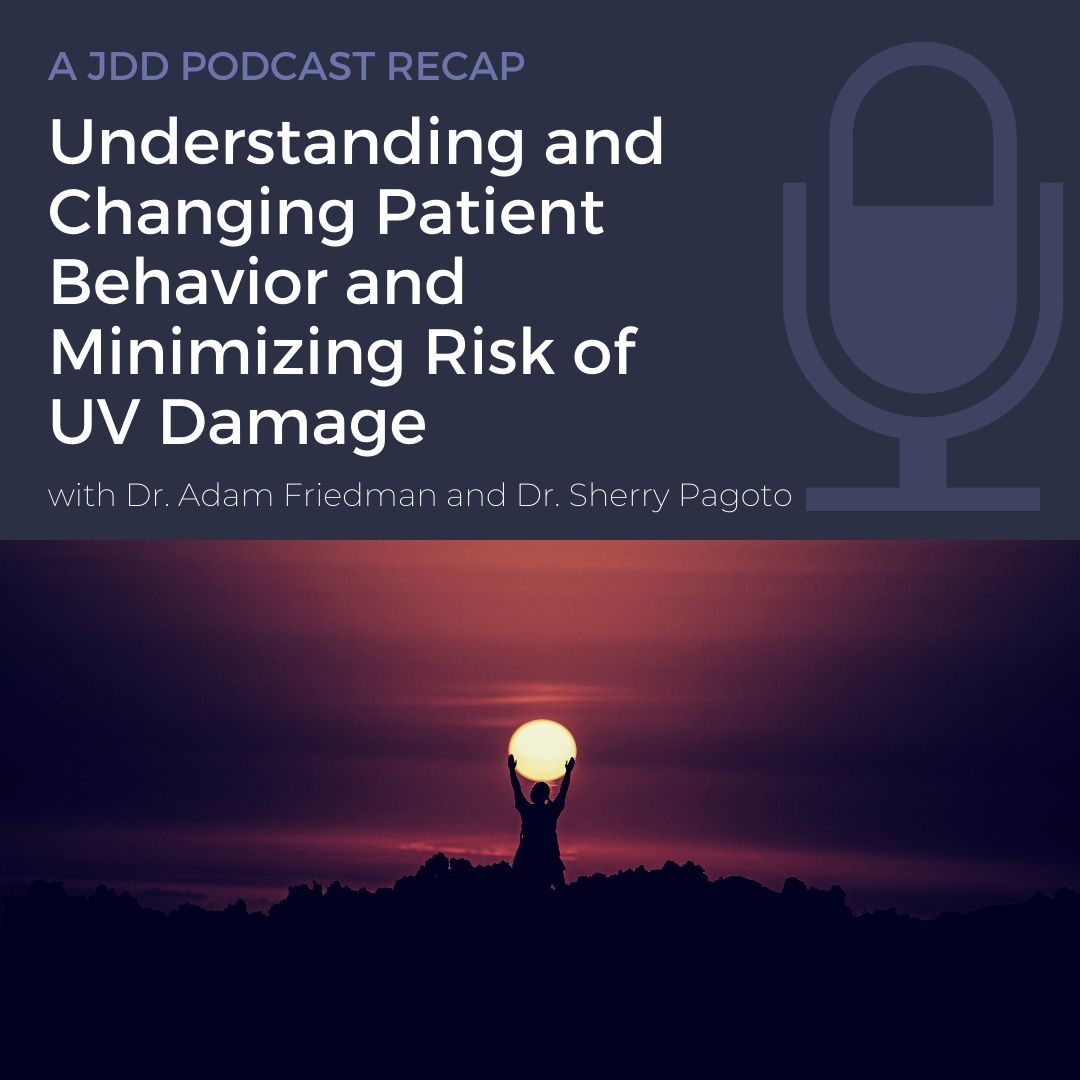We all discuss sun protection with our patients. At this point, our recommendations are predictable – “avoidance, protective clothing, SPF 30+, broad-spectrum, water-resistant, and reapplication.” But how can we effectively change patient behavior?
A recent JDD dermatology podcast featuring Dr. Adam Friedman and mental health expert Dr. Sherry Pagoto has provided us with new ways to approach this discussion. In the podcast, Dr. Pagoto and Dr. Friedman provide an excellent opportunity to learn from another specialty about how we can better care for our patients. You can hear the dermatology podcast for yourself here.
This review will provide an overview, including:
-
- Why patients partake in risky and/or unhealthy behaviors
- Strategies leading to effective clinician-patient dialogues that can better motivate patients to integrate regular use of sunscreens/sun protection in their skin care regimen
- Leveraging social media to educate the population about sun protection
Before we get into the full review, here are my “practice barometers” – what I took away from the podcast that may change my practice or confirm my standards:
 Continue to discuss sun protection with every patient as it has wide preventative effects for skin cancer, dyschromia, wrinkles, etc. I typically work this in during the exam. Want to know tips for motivating patients? Keep reading!
Continue to discuss sun protection with every patient as it has wide preventative effects for skin cancer, dyschromia, wrinkles, etc. I typically work this in during the exam. Want to know tips for motivating patients? Keep reading!
 Be active on social media with non-medical individuals in addition to medical colleagues, as this can be a powerful way to reach our target audience. What’s the best way to make an impact? Look below!
Be active on social media with non-medical individuals in addition to medical colleagues, as this can be a powerful way to reach our target audience. What’s the best way to make an impact? Look below!
 I should ask patients what might motivate them to use sunblock. What can be personal motivators to sun protection? Let’s see!
I should ask patients what might motivate them to use sunblock. What can be personal motivators to sun protection? Let’s see!
 Help patients make healthy behaviors the “easy option.” I am not doing this as well as I can. We can all do better by taking tips from this podcast!
Help patients make healthy behaviors the “easy option.” I am not doing this as well as I can. We can all do better by taking tips from this podcast!
Why do patients pursue unhealthy behaviors?
-
- Most patients know that unprotected UV exposure is unhealthy, but that knowledge alone isn’t enough to change behaviors because there is a lack of immediate reward from photoprotection
- Many unhealthy behaviors “do something for us”. In the case of sun protection, the unhealthy behavior has a benefit – less effort, less time, avoidance of skin/eye irritation or filmy feeling on the skin
- For lighter skin individuals, sun protection may have some more immediate benefit as they limit a sunburn. For many others, the immediate benefit is not seen
- Conversely, there is a benefit to this unhealthy behavior. Sun protection requires effort, it may not feel nice on the skin, it may burn the eyes, and it can be monetarily costly
- Studies have shown that knowledge of what is healthy does not necessarily translate to a change in behavior
What are the barriers for patients in regular use of sun protection?
-
- Compliance may improve momentarily after an appointment, but then tapers until their next appointment
- One of the dermatologist’s aims is to motivate patients to wear sunscreen daily – a truly high bar. Many may wear sunscreen at the beach or other high-intensity exposures, but how do we accomplish daily wear?
- We need to ask patients about barriers (and realize each may have differing reasons). Is it time, eye irritation, skin irritation, feeling on the skin, and/or cosmetic issues? Then help the patient decide which formulations may reduce those barriers
- Some patients may not mind a “passive tan” – meaning they aren’t concerned about intermittent sun exposure
- Ask how much it bothers the patient if they end up getting a tan with outdoor exposure
- How much time are they spending outside?
- Problem-solve with the patient as to how they can incorporate sun protection
- Many may still think that the appearance of a tan is a “healthy glow” or that the social perception of a tan is a “good thing”
- It’s important to match this appearance-based disconnect with appearance-based reasons to use sun protection
- Does the patient want to “hit the brakes” on their aging or “hit the accelerator”?
Do scare tactics work?
-
- 1 in 3 Americans get skin cancer in their lifetime, 2 or more people die each hour from skin cancer in the US. (more interesting facts and statistics at https://www.skincancer.org/skin-cancer-information/skin-cancer-facts/
- For some reason, scare tactics don’t seem to work as well as one would think. Why?
- Is the statistic actually scary to someone? Many patients may just feel they “won’t be the one”
- More important to personalize it rather than discussing statistics. What will the benefit and/or risk reduction be for the person in front of you?
- Fear can be motivating, but it is important not to “paralyze” the patient with fear where they don’t feel they have any control (which can have the opposite effect)
- Consider UV photos (showing patients their photodamage) and discuss how you can improve or prevent the damage
How can we motivate to daily use?
-
- Personalize the discussion to the patient to figure out the potential motivations that would lead them to better sun protection (as above)
- Ask patients to tie the sunblock to another habitual process that they already undertake – “keep it near your toothbrush”, “next to your makeup/lotion/lipstick”, etc.
- If they are having a hard time forming a habit, they can also place it in multiple locations – “put a bottle next to the door”, “put a bottle in your car”, “place a bottle in your purse” – this gives the patient multiple chances to utilize sunscreen during their daily routine
- By doing this you can “make it easy to make the healthy choice”
- Three aspects of behavior change
- 1) People are different
- 2) Context matters
- 3) Things change
- To expand this – each person has different motivators and barriers, a time or place may change the behavior (vacation, sports, social event, etc.), and as our life changes, our motivations and barriers change.
- Therefore, the discussion of sun protection is important for our patients – even if they are considered a model user of sun protection strategies
- Consider also using their cell phone to set reminders for re-applying sunscreen – every 2 hours when outdoors
How can social media be utilized to improve patient use of sun protection?
-
- Social media can help create social norms which can lead to a shift in society’s relationship and interpretation of UV exposure – changing the “the healthy glow” perception to an indication of “skin injury”
- Use Instagram, YouTube, TikTok, Facebook, etc.
- Create content that tells your personal story. The science is important, but personal stories and recommendations (putting yourself out there) can be more impactful
- Utilize target audiences through makeup or cosmetic influencers to help send the message of sun protection – also consider golfers, athletes, and beachgoers as far as social media networks
- When using social media, consider talking to the general audience (a target audience) and not just other physicians!
How do you motivate your patients to create healthy skincare habits? Please share your comments and join the discussion at the end of this post, and on Instagram @nextstepsinderm!
Dr. Sherry Pagoto is a Professor in the Department of Allied Health Sciences at the University of Connecticut and Director of the UConn Center for mHealth and Social Media.
Dr. Adam Friedman is the Interim Chair of Dermatology and serves as Residency Program Director, Director of Translational Research, and Director of the Supportive Oncodermatology Program in the Department of Dermatology at The George Washington University School of Medicine & Health Sciences
This information was presented by Dr. Sherry Pagoto and Dr. Adam Friedman during a JDD Dermatology Podcast on October 7th, 2020. The above highlights from their discussion were written and compiled by Dr. James Contestable, staff dermatologist at Naval Medical Center Camp Lejeune.
Did you enjoy this JDD Dermatology Podcast Recap? You can find more here.

